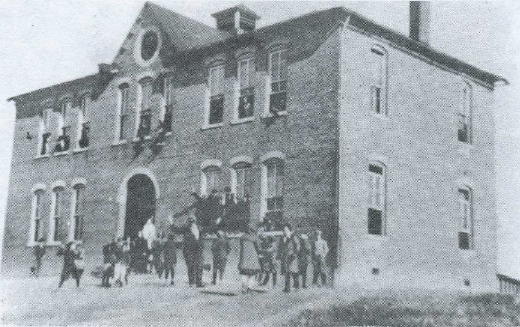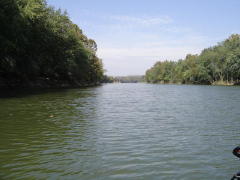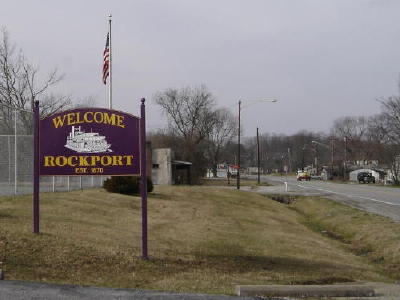Click to play music.
Bluff Street.
Rockport, KY. USA
A jrd stat on 12/7/09

A Web Page by j r durham..10/10/02
Revised on 5/10/07
Reworked Code on 8/12/15
A Street in Rockport is named Bluff Street
and a school building was situated on that street! Hum, what do you know about the
near famous street? Hope you know more than I do, as I was not aware of any street
names in Rockport until ten or so years ago. I can tell you what I know and may
put down more info than I have knowledge.
Bluff Street is an East to West Street and it starts in the East at the Mason Cemetery
and runs West past where Flossie and Dave Wilson lived, up the hill past where Shim
McCombs lived and then past Alva Decker's and the Park's, where it runs into the old
highway 62. Think that this street is named Main Street. If you turn right at this
intersection you would soon be going up Bob Swain Hill, but that is another story.
Bluff Street crosses Main Street, and just a few years ago you would need an ATV to
drive up the steep hill. Now, this street section, in the area where June and Analee
Fulkerson lived, has been restored and freshly graveled. Once up the hill, and in
the area below the old Rockport Cemetery, the road levels off. It will only last
for a few more blocks where it will end at the top of a bluff. This bluff is a
buffer zone between Rockport and the Green River, as it parallels the river and
runs from the old Jackson Hill area and past the highway bridge where it becomes
"Tank Hill". Then it becomes river bottom land again. There are two cemeteries
in Rockport, one on each end of Bluff Street. Why this particular street was named
Bluff Street is unknown to me, as about any street in Rockport could be associated
with a bluff of some sort.

"Rockport High School. 1908-1933."
At the East end of Bluff Street, and what
is now the Mason Cemetery, once stood a nice two story school building. There is
still some foundation left, but mostly the hillside is overgrown with brush on all
sides except the entry side. In 1908 the town of Rockport purchased this hillside
and built a school house. Later on that same year, school was held in the new school
house and it would be home for the students of Rockport for the next twenty-five
years. At first, the school was a two-year high school, but in 1926, the first
four-year students graduated from high school. In 1933, a fire believed to have
started from the furnace, destroyed the two-story school house.

"The Green River"
The school building burned before I was born and the only image that I have of the
building is from a few old pictures. By the time that I was able to look over the
school property, it had been deeded back to Rockport for a cemetery. Bluff Street,
back in the nineteen fifties, was a gravel street and was maintained by the town of
Rockport. The gravel part was awfully thin by the time a person went pass the Wilson
house. If a school bus used a street, some County Maintenance could be expected,
but don't expect very much. A levee had been built at the bottom of the hill to
position the street a few feet above the lowland and the dry creek bed. When Green
River flooded, this levee would be under water. A visit to the cemetery or a burial
could have to be postponed due to the condition of the street.

Somewhere around the middle of the twentieth century, a group of Rockport citizens
decided that the Bluff Street roadway needed some changes. A levee of a hundred
yards or so had previously been built to place Bluff Street higher than the low
land in that area and a small wooden bridge provided an access for crossing the
mostly dry creek bed. At best the levee was not high enough to prevent flooding
and if the Green River was in "Flood Stage", the flood water would be over the road.
The small wooden bridge over the dry creek bed was also in need of repair. The
entire levee area was also covered in brush and weeds. A problem existed and the
good people rose to the task at hand.
Help Needed!

I don't know who the "Road Construction" crew leader was, but probably Lester Durham.
All that I know was that I was invited (forced) to spend a week-end working with
this new crew to rebuild the old roadway. I don't remember very many names of the
gang, but do recall that there were twenty or so men and a few boys ready to spend
the week-end to build up the levee, cut the bushes and build a new bridge. Martin
Durham, Russell Blades, Dellie Singleton, Fat Givens, Thomas Harris, and Peck Harris
are just a few of the men that were probably in the crew. I realize that I have
left out a few and probably have added some. I don't remember Jamie Reid being in
any of the work crews, but you can bet that he furnished most of the material. The
crew was mostly composed of the men from Cherry Hill Mines. A few fathers brought
along their sons, thus I was not the only pre-teen or early teen that was invited.
Delbert Harris and Donnie Singleton were two of the boys and I think there was a
few more. Anyway, for all that we were worth, we did last the two days. Our lunch
was furnished by the wives of the crew members.
To build or re-build a road, about all that would be needed is a "Cat", and maybe
a surveyor, a few people to build forms for the bridge and a tractor with a bush-hog.
That is now. This was then-Rockport did not have access to any of the just mentioned
equipment or people. All that was available was several good men and a few boys.
Our construction team was divided into three crews; (1)The bridge building gang,
(2)The brush cutting gang, and (3)The levee building gang.

The Bridge Gang-Lester Durham took four or five men and they started building forms
and getting ready for the concrete pour. Before the sun went down, they were well
on the way of completing the bridge across the ditch or the dry creek bed. Once
the forms were constructed, the concrete was mixed by hand in wheelbarrows and poured.
They would have no problem completing the bridge the next day. I was to busy to
look in on this crew and about all that I know, the job was completed. Part of
that crew probably switched over to the "Levee Gang" before all was done.

The Brush Cutting Gang-Martin Durham took a few good men with strong backs and most
of the young boys for his crew. Delbert Harris, maybe Donnie Singleton, and I were
selected for this crew. There was probably a few other young boys, but I can't
remember any others. I can visualize Russell Blades, in his overhauls, doing some
cutting as well as checking on us boys. With mostly hoes, mattocks and axes, we
started cutting weeds, bushes, and saplings. We also had a "Briar Scythe" and each
young boy had to try it out. If you have ever seen or used a briar scythe, you
know that a young boy could not last long using that tool. The scythe consisted
of a curved,long wooden handle with two adjustable hand pieces for holding the cutter
and a cutting blade that looked like it was three feet long. They were mostly used
for cutting seed and silage crops, but were adapted for brush cutting, especially
"briars", thus the name "Briar Scythe". We always called the implement a "Briar
Size", but that is just more Kentucky brogue. I doubt that the young gang members
were worth much, but I know at the end of the day, this old retiree was one tired
boy. This levee was three hundred or so feet long and the brush and saplings were
on both sides, thus there was a lot of work in getting this part of the job done
in two days.



The Levee Building Crew-I don't remember the crew leader, but am thinking that Thomas
Harris, Alva Decker, James Barnes, Fat Givens, Henderson Key, C. L. Marlow, "Mawh"
Porter and Cecil McCoy, along with a few others were in this crew. This was the
exciting crew and the crew that most of the boys desired to be in, but could only
watch. I remember this crew, more so that the others, as I was always watching.
Probably did more watching that working, that is until Russell Blades reminded me
that I was in the "Brush Cutting" crew. Anyway, this crew had at least two "Scoops",
probably more. A "Scoop" was a type of a dragline bucket and was pulled by a horse
or mule. The "Operator" would manipulate a handle on each side of the scoop to
control the depth of the bucket and would use harness reins to control the horizontal
direction of the scoop by turning the horse or mule. Sounds simple, but it was not.
It was much like using a plow and a team of mules to break new ground. Anyway, with
at least two "Scoops", shovels, mattocks, axes, rakes and other implements, that
crew proceeded to scoop up dirt and such from the low land and move it to the levee.
I can remember Thomas Harris, in his Twenties, with reins in hand and behind a horse
and a scoop. He would direct the horse to the dig area, flip the scoop over so that
it would cut or dig, and control the depth of the dig until the bucket was full.
Now, it was time to bring the scoop out of the dig area and take it to the levee.
Once on the levee, the scoop would be flipped back to the dump mode and a "Scoop"
of dirt would be left for others to tamp and level. This process continued and when
a "Scoop" operator tired, another operator took his place. Hour after hour and in
two days, a foot or so of new dirt was added to the levee. That was a lot of dirt
to be moved manually, but the desire was there as well as the will power. "Brawn
and Brains", in conjunction with a desire and a need. Mission accomplished.
A young boy, eleven or twelve years old, working with twenty or so grown men for
two days and sharing lunch, certainly would pick up a habit or an idea or two.
Guess that I did learn the value of work during this event in time, but the one
habit or idea that I picked up was to look back at what you have done. At the end
of the mission and as the day was ending, most of the men relaxed and just sat back
and took in the view of what they had done. I was just glad that the work day was
over and that "Ending" period gave me a time to rest. None-the-less, to this day,
if I ever start any type of project, I will end that project by just sitting back
and looking at the completed job. Lesson or habit learned.
As stated earlier, I did not want to be at that work location. Heck, I could have
been fishing or roaming the hillsides. It was requested that I participated and
along with a few other boys, I stuck it out until the job was completed. My father,
along with others, told all of us youngsters that in fifty years we could cross the
levee and look back in time to remember being a part of a crew that re-built the
levee. Well, he was right. Since then, I have crossed that old levee many times
and there was not one crossing that I did not remember those "Good Old Days" in the
late forties and early fifties.
Gosh, I kept pounding on this old keyboard and have gotten long on material. If
you are still with me on this, thanks for looking and for reading. If you are not
here, I can understand.


Picture of Rockport as it looks today. view is looking West toward
the Highway Bridge
The J. R. Durham's














